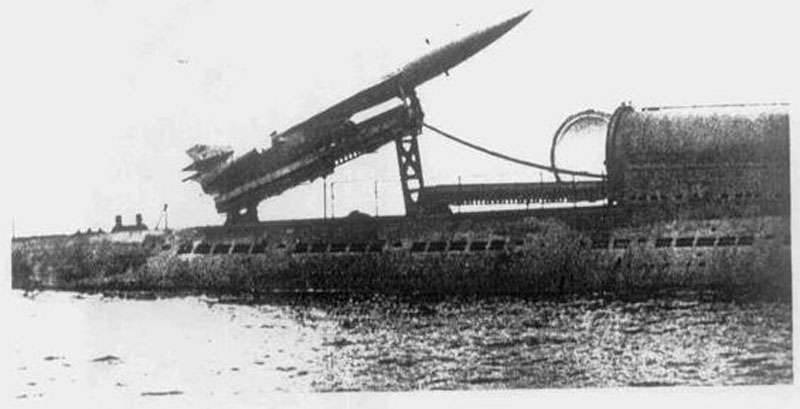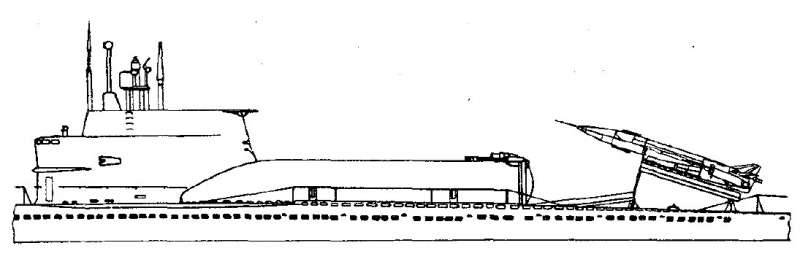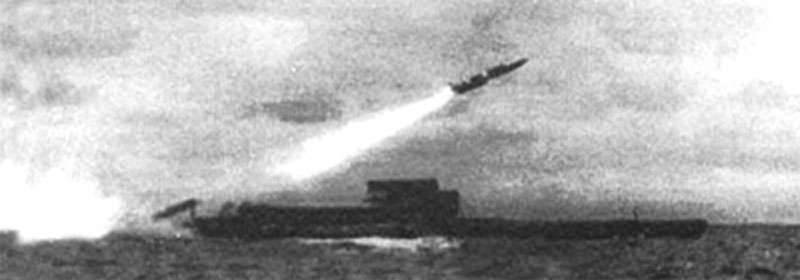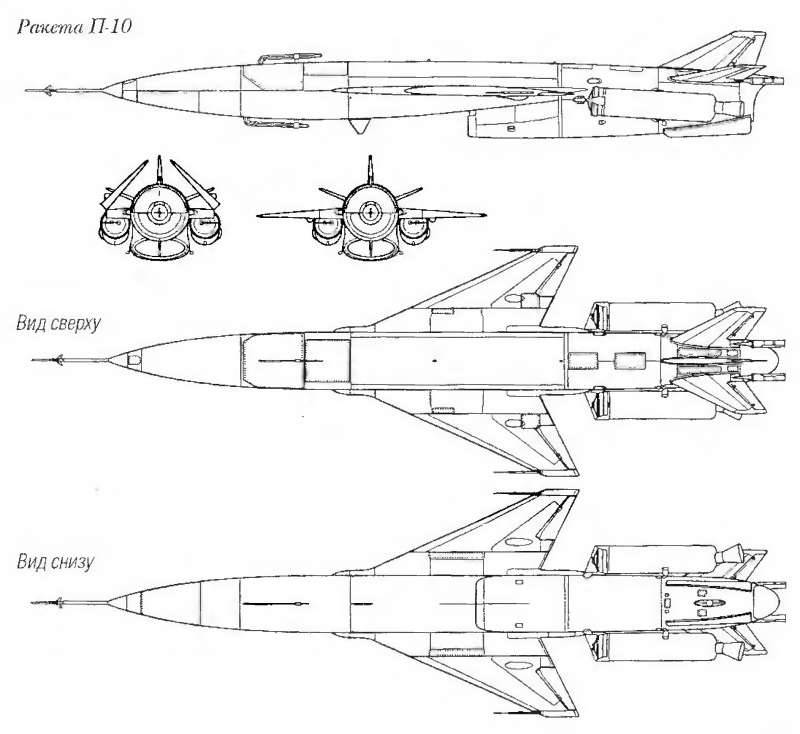Cruise missile submarines P-10
In 1954, it was decided to create new projectiles (cruise missiles) to arm promising submarines. Like weapon intended to defeat areal surface and coastal targets with previously known coordinates. In accordance with the decision of the Council of Ministers, which determined the requirements for new weapons, the development of two projects started. OKB-52 under the direction of V.N. Chelomey was engaged in the P-5 rocket, and in OKB-49, headed by G.M. Beriev, work began on the project P-10.
The aim of the two projects was to create a new guided missile with a range of at least 300 km, capable of delivering a high-explosive or special warhead to the area target. Prospective rocket was supposed to be the main attack weapons of submarines of a new type. In this connection, it was necessary to develop not only a rocket, but also systems for its storage and launch from a submarine.

Rocket P-10 on the launcher, mounted on the submarine B-64. Autumn 1957. Photo by Youroker.livejournal.com
The development of the P-10 project was associated with significant difficulties. Before receiving the corresponding order, OKB-49 was engaged only aviation technology and never designed rocket systems. As a result, the specialists of KB G.M. Beriev needed help. In order to study new technologies, the bureau turned to colleagues for help. A number of OKB-49 specialists went on business trips to other organizations involved in the development of cruise missiles. The development of other people's experience allowed us to solve the main design problems and successfully complete the design of a new missile system.
The P-10 missile was designed to arm submarines, which affected its design. The product was supposed to have minimal dimensions, allowing it to be transported in a submarine carrier container. To meet these requirements, it was decided to use the appropriate layout of the rocket, as well as a folding wing. With such solutions, the transverse dimensions of the product in the transport position could be reduced approximately by half relative to the flight configuration. It should be noted that similar ideas were implemented in the P-5 project, however, it used other wing opening mechanisms, launch methods, etc.
The cruise missile of the new model received a large elongation fuselage of complex shape. Provided with a pointed head fairing, which passed into a cylindrical fuselage unit. In the middle part of the fuselage, the bottom rose, reducing the height of the structure in front of the air intake. In the tail part of the rocket there was a propulsion turbojet engine, the nozzle of which was discharged through the rear section of the fuselage.
In the middle part of the fuselage, it was proposed to mount the middle wing of a large sweep. The wing consisted of a relatively narrow fixed center section and folding consoles. In the transport position, the consoles should have been folded upwards, after which the transverse envelope was limited only by the tail and the starting engines. In the rear part of the fuselage, it was proposed to mount the arrow-shaped keel and horizontal plumage with a noticeable transverse V. On the wing, the stabilizer and the keel, rudders and ailerons were provided for control during the flight. Below the stabilizer, on the sides of the engine compartment, there were mounts for two starting engines, made in the form of cylindrical blocks with nozzles on the tail ends.
The power plant of the P-10 rocket was to consist of two main components. For the initial acceleration, set speed and altitude, it was proposed to use two solid fuel starting engines PRD-26. After the production of fuel, these products should have been reset. For the flight on the main part of the trajectory, a new turbojet propulsion engine was developed. In collaboration with OKB-300, OKB-49 created a short-resource modification of the RD-9B engine under the designation KRD-9. This product could develop traction up to 2500 kgf, and reducing the life of the structure to the minimum allowable values made it possible to simplify and reduce the cost of production.
Due to the lack of alternatives and due to the peculiarities of the initial specification of the P-5 and P-10 missiles, they were to be equipped with inertial guidance systems capable of ensuring the missile’s flight to the specified point, but without the ability to search for the target and direct it to it. Thus, the P-10 rocket received an autopilot with an altimeter and a set of other equipment. Before launching, the crew of the submarine carrier was supposed to memorize the flight pilot to the autopilot, after which he himself could take the rocket to a given point with acceptable accuracy.
The new rocket was able to carry high-explosive and special combat units. Depending on the tactical situation and the combat mission received, the submarine could destroy the target with the help of several quintals of explosive or with the use of an RDS-4 item with a power of 30 kt. Such combat equipment made it possible to inflict noticeable damage not only on individual targets, but also on enemy ship groups.
The finished development rocket OKB-49 had a length of 11,125 m and a wing span of 3740 mm (unfolded). The total height of the product was equal to 1,7 m. Due to the folding wing, the cross-section of the rocket could be reduced approximately by half, however, no other means of reducing the dimensions in the transport position were provided. Thus, the P-10 rocket required the use of a relatively large transport container.
It was proposed to launch a promising missile using a relatively complex launcher, including a transport container, guides and other devices. The main unit responsible for storing all other items was a cylindrical container of the desired dimensions. The container was proposed to be fixed on the sturdy hull of the submarine carrier. The rear end of the container was closed with a movable lid. Behind the container on a light body, special rails should be mounted to move the launcher.
On rails equipped with toothed racks, a special trolley with mounts and guides for the rocket had to move. To move the truck had an electric motor with remote control from the console at the control station of the missile complex. In preparation for the campaign of the submarine, the P-10 rocket was to be fixed on the trolley. Rails consisted of two parts, the so-called. intermediate and starting frame.
It should be recalled that in the P-5 project, the OKB-52 specialists managed to solve a number of critical tasks and ensure a relatively quick and easy launch of the rocket. Floating to the surface, the carrier had to lift the rocket container to a small starting angle and open its lids. After the launch command, the rocket turned on the powder engines and exited the container, moving along short “zero” guides. Immediately after leaving the container, the automatics had to open and fix the wing. Creating the required systems, such as the automatic disclosure of the wing, took a long time, but such principles, having shown themselves well in practice, are still actively used in the field of rocket weapons.
The launch of the P-10 rocket was supposed to look different. After the ascent, the submarine was supposed to open a single lid of the transport container and take the rocket cart (tail forward) out of it. Moving to the stern, the cart on rails took the rocket out of the container. At this time, a separate command from the console carried out automatic wing opening. In the rearmost position, the cart had to drive onto the rails of the launch frame, equipped with its own hydraulics. The task of the latter was to lift the frame, carts and rockets at the starting angle 20,5 °. After lifting the frame was fixed with struts.
According to reports, the equipment for controlling the missile system installed on the carrier had an interesting feature. All operations to prepare for the launch of the rocket should have been carried out automatically after pressing just one button. Upon completion of all operations, the complex was completely ready to press another button - it was responsible for launching the rocket and attacking the target.
Upon command from the console, the rocket was supposed to turn on the main turbojet engine and bring it to maximum speed. The launch was carried out by simultaneously starting two powder engines. With their help, the rocket descended from the short guides, passed over the deckhouse of the submarine, and began its flight. After the charge was developed, the boosters were proposed to be dropped, and further flight was to be carried out using the rocket’s own engine.
The characteristics of the power plant, fuel, autopilot and aerodynamics allowed to fly at a distance of 600 km. The flight could be made at altitudes from 200 to 400 m. Due to the lack of precision in inertial guidance and the lack of instruments to search for a target at maximum range, the rocket could hit only areal targets of relatively large size.
In the first half of 1956, several models of the P-10 rocket were made, which were intended for use in flight tests of the first stage. From a full-fledged combat missile, similar products differed in the set of equipment and design. In addition to the weight simulator of the warhead, the mockups received a simplified airframe design. So, instead of a number of metal parts were used wooden. In addition, the mock-ups had a simplified composition of the on-board equipment, since they were intended for carrying out throwing tests and checking the operation of launch systems.

The launcher of the P-10 rocket on the submarine of the P611 project. Figure Shirokorad AB "Fire sword of the Russian fleet"
The first tests began on July 21 1956, one of the Crimean polygons. 21, 25 and 27 July were performed three throw start from the ground installation, during which the operation of the starting engines and their reset mechanisms was checked. The models themselves, respectively, fell at some distance from the launcher. The products of PRD-26 and related equipment have shown themselves well, which made it possible to continue work on the project.
Tests of the second stage were carried out at the Kapustin Yar test site using a swinging stand, built on the basis of the CM-49 container for the P-5 rocket. The original product was supplemented with a set of rails, lift hydraulics, a transport cart, etc. From 11 March to 17 May 1957, this system performed five rocket launches. During the first three launches, the stand was stationary, and in the last two it imitated the pitching roll of the submarine carrier. During these launches, it was possible to bring the flight range to 120 km. In this case, the flight speed was noticeably less than the calculated one. The project envisaged a flight with a maximum speed of up to 360 m / s, whereas experimental products developed only 320-350 m / s. Some modifications of the power plant and control systems were required.
One of the five prototypes tested at the Kapustin Yar test site was lost as a result of the accident. After leaving the launch rails, one of the starting engines did not separate, due to which the product lost stability and fell a couple of kilometers from the launcher. Four other missiles in general fulfilled the tasks and showed trouble-free operation of the equipment, although they could not confirm the calculated flight characteristics.
The following checks of the new missile system were to be carried out with the help of a specially converted submarine. Preparations for this began in the middle of 1955. In accordance with the resolution of the Council of Ministers, TsKB-18 began the development of the project of the submarine P611. The purpose of this project was to re-equip the 611 project submarine with the installation of launch systems and other instruments for the use of the P-10 rocket. Minimal design changes were assumed, which made it possible to build a trial boat on the basis of the existing drill submarine.
In August, 1955 of the year was the start of the development of the 642 project. Such a submarine, based on the design of the existing technology, was to carry two P-10 missiles. Work on this project lasted about a year. In August, 56-th, it was decided to abandon the similar submarine. The project is closed. Also from April 1956, the 646 project was created, one of the variants of which meant the submarine’s arming with two P-10 missiles. The second version of the project was to use four containers with П-5 products.
At the end of spring 1956, the new P611 project was approved by management. He meant re-equipment of the existing submarine of the 611 project with the dismantling of feed equipment for loading torpedoes and artillery weapons, as well as with the reduction of stocks of fuel and fresh water. After removing all the "extra" units in the stern of the submarine, the container and other devices were attached for the use of P-10 missiles.
After the approval of the P611 project, a potential carrier of the new missiles, which became the B-64 diesel-electric submarine, was chosen. She was sent to the plant number 402 (Severodvinsk), where all the necessary refurbishment work was performed in accordance with the updated project. In the middle of 1957, the submarine B-64 was ready to participate in missile testing. After reworking, the submarine differed from the other boats of its project in the presence of a large container behind the cabin and rails for the trolley. In addition, new control panels for the missile complex appeared at the central post.
23 September 1957, the submarine B-64, being on the proving ground in the White Sea, first launched the P-10 missile. During start-up, the carrier moved at a speed of 7 nodes, the excitement did not exceed the 1-2 score. The launch was successful, but after 70, after the flight began, problems began with the operation of some rocket systems. A minute and a half after the start, the hydraulic system finally failed, and as a result, the autopilot lost control of the rocket. After 15 since then, the P-10 rocket fell into the sea, flying a total of 30 km.

One of the test launches of the fall 1957 of the year. Photo Militaryrussia.ru
28 September the second launch took place. This time the rocket was able to fly almost 200 km, but did not hit the conventional target. On the way of the rocket flying at a height of less than 200 m, there was a knoll. The rocket crashed into an obstacle and collapsed. The third launch of October 17 passed without collision with unforeseen obstacles, but did not end with a conditional defeat of the target. Due to engine problems, the flight speed did not exceed 320 m / s, which resulted in premature fuel production. The rocket fell in 240 km from the starting point.
31 of October was observed in difficult weather conditions: wind to 17 m / s and swell to 6 points. Despite this, the fourth prototype rocket launched by the B-64 submarine flew to the conventional target and hit it. Successful completion of the first stage of testing in a submarine allowed to continue the checks and begin preparations for state tests, as a result of which the missile system could count on being put into service.
The testing of the P-10 missile on the B-64 submarine is connected with an interesting story described by the project participant A.G. Bogatyrev. During one of the test launches on board the submarine, not only the crew and representatives of the design bureau, but also the commander of the Northern Fleet, Admiral A.T. Chabanenko. After announcing the twenty-minute readiness for launch, the admiral ordered the boat commander to go to the central post and report that the entire crew was inside a strong hull. The commander, thinking that the admiral had also returned to the submarine, gave the order to close the entrance hatch.
After launch, the crew discovered that all this time the commander of the Northern Fleet was on the deck of the submarine. However, accidentally forgotten outside the boat A.T. Chabanenko was pleased with the launch. In addition, he, taking advantage of the moment, conducted a small experiment: he put a hat on the deck, wondering if it would be blown away by starting engines. Also, the admiral took precautions by hiding behind the wheelhouse. Despite the testimony of the testers, the admiral was completely satisfied with the launch.
The P-10 rocket had notable prospects, but it did not reach full-fledged fleet operation. The P-10 project was ahead of the P-5 in terms of deadlines, but at the same time it was lagging behind in a number of other features, primarily in its characteristics. So, the P-5 rocket designed by V.N. Chelomey, with similar flight data, was slightly smaller, lighter, and also started right from the shipping container. The last feature of the rocket allowed to sharply reduce the time during which the submarine had to remain on the surface. As a result, the P-5 was of much more interest to the Navy than the P-10.
According to the results of the tests, a decision was made about the further fate of the two projects. 31 December 1957 year The Council of Ministers decided to stop work on the P-10 rocket and continue the development of the P-5 project. Shortly thereafter, the submarine B-64 again went to the restructuring of the original project 611, and further development of carriers P-10 was canceled. A few years after the P-10 project was closed, the P-5 rocket was put into service and later became the main attack weapon of several dozen submarines of a number of projects. In addition, based on it, new missiles and missile systems were developed. The P-10 project at a certain stage became the basis for the promising P-10B supersonic seaplane, however, due to the rejection of further project development, work on it was discontinued. In the future, the developments in the P-10 perspective project turned out to be unclaimed.
Based on:
http://testpilot.ru/
http://arsenal-info.ru/
http://submarine.itishistory.ru/
http://epizodsspace.airbase.ru/
http://mydocx.ru/
Shirokorad A.B. Weapons of the domestic fleet. 1945-2000. - Mn .: Harvest, 2001.
Shirokorad A.B. Fire sword of the Russian fleet. - M .: Eksmo, 2004.

Information